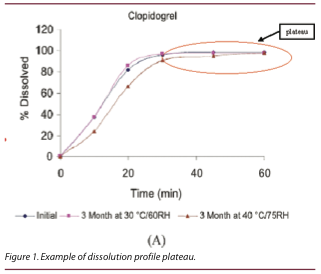
William Brown and Margareth Marques
The following questions
have been submitted by readers of Dissolution Technologies. Margareth
Marques, Ph. D. and Will Brown, United States Phamacopeia, authored
responses to each of the questions.
*Note: These are opinions and interpretations of the authors,
and are not necessarily the official viewpoints of the USP
Email for correspondence:
web@usp.org
Q
The USP procedure for the qualification of Apparatus 1 and 2 says to run two tests for each apparatus in Stage 1. What is the rationale behind this recommendation?
A
The design of the Performance Verification Test (PVT) using USP Prednisone Tablets RS is based on ISO proficiency testing procedures that have been modified to apply to the various configurations of dissolution test assemblies (e.g., 6-, 7-, 8-, and 12-position equipment). The basic test should have no fewer than 12 results; thus for 6-, 7-, and 8-position equipment, the single-stage test requires two complete runs, while for a 12-position test assembly only one run is needed. USP has stakeholders who have requested the option of performing the PVT in two stages. Therefore, USP has designed such an option where the first run results can be analyzed for conformance, and if necessary, the second run is performed. In order to keep the overall chance of success equivalent between the single-stage and the two-stage procedures, different criteria are applied.
USP personnel have published a research paper on the subject of ranges for the current lot of RS tablets. By accessing that paper and the references cited, you may gain a better understanding of the development process for this new approach. An abstract of the paper can be viewed at http://www.pharmagateway.net/ArticlePage. aspx?DOI=10.1007/s11095-010-0295-3.
Q
What is the exact meaning of plateau in dissolution profiles?
A
Plateau is a region of little or no change in the dependent variable of a graph. In a dissolution profile, it is
a region with little or no change in the amount of drug dissolved in the medium. See Figure 1 from:

Huang, Z.; Lozano, R.; Francis, R.; Aubry, A. F.; Steckbeck, A.; Sciascia, D. O. Development of a single in vitro dissolution method for a combination trilayer tablet formulation of clopidogrel and pravastatin. Dissolution Technol. 2011, 18 (1), 12-19.
Q
The USP General Chapter <711> Dissolution, under Dissolution Performance Verification,
Apparatus 1 and 2, states, "Test USP Prednisone Tablets RS according to the operating
conditions specified. The apparatus is suitable if the results obtained are within the
acceptable range stated in the technical data sheet specific to the lot used and the
apparatus tested." The USP Certificate for USP Prednisone Tablets RS lot P1I300 for
Dissolution Performance Verification Test (PVT), dated 22-Feb-2010, states, "Heat a
suitable amount of water, while stirring gently to about 45°" and the "measured vacuum
should be less than 100 mbar." However, the USP General Chapter <711> Dissolution states,
"One method of deaeration is as follows: Heat the medium, while stirring gently, to about 41°,
immediately filter under vacuum using a filter having a porosity of 0.45 µm or less, with
vigorous stirring, and continue stirring under vacuum for about 5 minutes. Other validated
deaeration techniques for removal of dissolved gases may be used."
A
The purpose of degassing the medium for the USP Prednisone Tablets RS used in the PVT is to ensure that dissolved gases do not interfere with the results. For the effect of dissolved gases on the dissolution results of USP Prednisone Tablets RS, please refer to:
there was a footnote explaining the deaeration procedure where the temperature of 45 °C was recommended. In USP 34 (2011), the temperature recommended for the same procedure is 41 °C.The difference between degassing the medium at 41 °C and 45 °C is seen in the temperature
equilibrationtimeafterdeliverytothedissolutionvessel or assembly. The change to a lower temperature was a result of comments that a 45 °C treatment required a longer time to start the run.
The pressure under which the medium is degassed has been found by the USP laboratory to produce a dissolved gas content that does not interfere with the results. The dissolution of prednisone from formulations has a well-earned reputation for sensitivity to dissolved gas in the medium.This may not interfere with bioavailability, but it is seen in the lab. Because a laboratory likely desires results of the PVT that will not fail because of the artifact of dissolved gas, following the USP guideline may not be a bad practice. Note that degassed medium will return to the saturated state in real time and thus should be used as fast as practicable upon degassing.
The dissolution of other products may not be sensitive to dissolved gas or may be less sensitive. Degassing should be evaluated as part of the robustness study during the development and validation of a dissolution test.